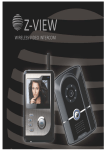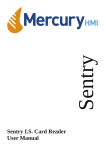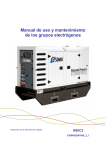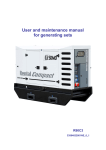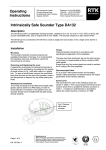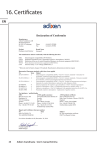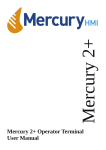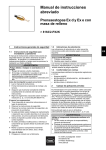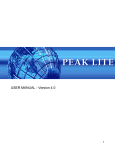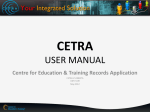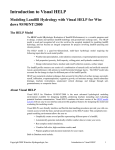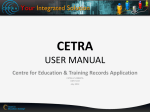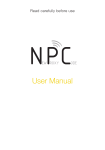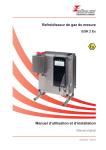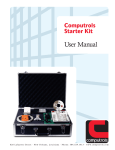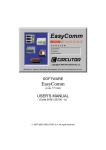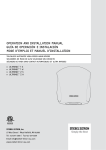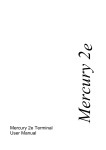Download Sentry I.S. Card Reader User Manual
Transcript
Sentry Sentry I.S. Card Reader User Manual Contact Mercury HMI Ltd George House Derwent Road Malton North Yorkshire YO17 6YB UK Tel: Fax: Email: Web Skype: +44 (0) 1653 697 200 +44 (0) 8700 667 325 [email protected] www.mercuryHMI.co.uk mercuryHMI Revision Information Rev Date 1 Changes Original Release 1.1 Mercury IMC Version 2.0 27 Jul 09 Substantial revision of the manual, for Wiegand O/P Mode, R507 barrier and Modbus enhancements. 2.1 6 Oct 09 All drawings re-drawn 2.2 2 Dec 10 The Digital Output driving page 17 has been revised. Table boundaries made finite thickness, to help PDF printing Extra reader type added Config string updated Links show Mercury HMI limited & logo. Certificate checked. 2.3 18 Mar 11 Added Special conditions of use The Sentry Cardreader has special conditions for safe use (denoted by X after the certificate number) applicable to it. There are 2 conditions applied, see section 15 of the Sira Certificate shown on page 30. Mercury HMI Ltd explanation of the special conditions for safe use 1. The Sentry Cardreader has areas of the enclosure that could generate static under some circumstances, and if the static were to build up then a spark could result. To avoid this risk, do not clean or polish the device with a dry cloth or position it where jets of high-pressure steam or other gases could blast over its surface. 2. This is a warning that the enclosure is made of LM24 grade Aluminium, and there is the potential for sparking to occur by impact or friction from objects hitting it. Hence position/protect the unit so that it is unlikely to be struck. All trademarks are acknowledged as the property of their respective owners. This document shall not form part of any contract. Specifications are subject to change without notice, and Mercury HMI Ltd accepts no liability of any kind for errors or omissions. Sentry IS Card Reader User Manual Page 2 of 41 2v2ODT091202 Contents Introduction .........................................................................................4 Certification Standard ........................................................................5 Installation............................................................................................6 Overview................................................................................................6 Mounting the Sentry Card Reader..........................................................7 Weatherproofing.....................................................................................7 Hazardous Area Connections.................................................................7 Safe Area................................................................................................9 Safe Area Connections..........................................................................10 Operation.............................................................................................11 Power On...............................................................................................11 Set Up & Configuration........................................................................12 Configuring the Card Media Type........................................................13 Configuring The Sentry Card Reader....................................................13 Configuration String .............................................................................14 Example Configuration String..............................................................15 Telemetry Block Structure.................................................................16 Escape Sequences..................................................................................17 Card Media Specifications....................................................................17 System Options....................................................................................18 Option1 - IS Sentry in Stand-alone mode.............................................18 Option 2 - IS Sentry in multi-drop mode..............................................18 Option 3 - IS Sentry in (standard) Modbus mode.................................19 Option 4 - IS Sentry in Mercury 2+ Modbus mode.............................22 Option 5- Safe Area Sentry Connections..............................................23 Option 6 - IS Sentry Wiegand Output mode.........................................23 Hazardous Area I/O Options.............................................................25 Sentry Expansion...................................................................................25 Appendix A - Certificates of Conformity.............................................26 Appendix B - Wiring Drawings............................................................32 Appendix C - Brief Guide to Card Technologies..................................38 Appendix D - Specifications.................................................................39 Appendix E - Sentry Product Flyer.......................................................40 Sentry IS Card Reader User Manual Page 3 of 41 2v1ODT091006 Introduction The Sentry card reader system is an Intrinsically Safe card reader designed to read a variety of different card types in hazardous areas. A complete Sentry card reader system comprises of 3 main components. • • • A R507 barrier mounted in the safe area The Sentry Base Unit, with the processing and communications electronics (P174 Board) affixed in the hazardous area, connected to the fixed wiring The Sentry Lid containing the appropriate reader head ( the reader electronics and a safety barrier encapsulated together into a module mounted behind the RF transparent window) and the status LEDS There are 3 variants of the Sentry Base Units • • • Hazardous area Serial communications version, supporting point to point, multi-drop and Modbus communications standards Safe area Serial Communication version Hazardous area Wiegand Output Version. A Wiegand Output kit comprising of a P510 Module and barriers is also needed. Currently there are four Sentry Lids available. These are:- • • • • Wiegand Swipe Card EM Proximity Card MIFARE Proximity Card HID Proximity Card ( H10301 & H10306 Format) Illustration 1: Hazardous area EM Card reader Sentry IS Card Reader User Manual Page 4 of 41 2v1ODT091006 Certification Standard ATEX Number Copies of SIRA certification No. 99ATEX2138X are included in Appendix A, showing EEx ia IIC T4, which is made up as follows:EEx = European certificate for hazardous areas. ia = Intrinsically Safe for Zone 0, continuous Hazardous vapours. IIC = Safe for ALL gas groups. T4 = exceed Component surface temperature cannot 130°C, i.e. safe for all gasses except carbon disulphide. The “Conditions of Certification” show the maximum parameters of each of the input/output terminal blocks. Nomenclature & Conventions In this manual, ASCII single characters which are either control or non-visible codes (Hexadecimal 00 - 1F, 20 and 7F) are indicated by enclosure in < >, for example, <ESC>. Character strings which are indivisible sequences are shown between quotation marks, for example, "<ESC> [ 2 J". In the ASCII 7 and 8 bit code sets used by Mercury 2+, a character is represented by two digits, each in the range hexadecimal 0 to F. For example, <SP>, the space character is defined (20H). Sentry IS Card Reader User Manual Page 5 of 41 2v1ODT091006 Installation Installation Overview The Sentry card reader has ATEX approval for use in hazardous areas when used with the R507 barrier & communications interface or a direct equivalent. The Intrinsically Safe Interface Module provides galvanic isolation between the 24V D.C. power & host communication ports and the I.S. hazard area connection These connections to the Sentry allow a cable length of up to 1 kilometre. The R507 communication ports provide for RS232 and differential transmit and receive terminals for RS422/485, with tri-state control. The Sentry should be ordered as a complete unit comprising electronics box and appropriate reader head as required. The Sentry can then be mounted on any convenient flat surface using the four holes provided. The dimensions of the box (excluding the card reader head) are shown in the diagram below. Illustration 2 Sentry Mounting Hole Centres Sentry IS Card Reader User Manual Page 6 of 41 2v1ODT091006 Mounting the Sentry To affix the Sentry Card Reader to a surface, prepare by drilling four holes 204 mm apart in width and 82 mm apart in height, refer to Illustration 2. Carefully remove the Sentry Lid containing the reader head and LEDs, supporting the lid so that the cables are not put under strain. If this is not possible, carefully remove reader head plug from J2 (see Illustration 4) and the LED assembly plug from J1 and store the reader head safely. Four mounting screws can now be used to attach the Sentry Base Unit to the mounting surface. Now plan how the hazardous area wiring is going to be terminated. For a simple IS installation, when the only connections are the 4 wires to the Sentry, use the centre gland. Weatherproofing The Sentry electronics box and card reader head are weather proof, so care must be taken to ensure the “O” ring seals are in place and free from grit when mounting the equipment. In salty or corrosive areas, it is advisable to grease the lid screws to avoid binding. There are three 20mm threaded holes provided in the box for cable glands. Any unused glands should be fitted with suitable weather blanking plugs. In its most basic configuration, Sentry wired to host, only one cable is needed (See Appendix B drawing number P174’112 and P174'113). Hazardous Area Connections For hazardous area applications, the cable connecting the R507 barrier & communications interface needs to comply with the following parameters: Loop resistance 40 Ω Maximum Capacitance 142 nF Maximum L/R Ratio 33 μH/Ω Maximum Inductance 0.6 mH Maximum In practice these parameters are easily met by standard cables; e.g. a 1 mm2 quad cable has approximately the following parameters: Sentry IS Card Reader User Manual Page 7 of 41 2v1ODT091006 Resistance Maximum 38 Ω /km (loop) Capacitance 55 nF/km Maximum L/R Ratio 2.5 μH/Ω Maximum Inductance Maximum 0.48 H/km For a cable length of 1km, this would satisfy safety and operating requirements. Illustration 4: Inside view of the Sentry, showing Key Components Sentry IS Card Reader User Manual Page 8 of 41 2v1ODT091006 Safe Area For hazardous area use, the Sentry must be connected to the R507 barrier & communications interface. The R507 must be located in the safe area. An illustration of the interface module, which is designed to be mounted on a DIN rail, is shown below. Illustration 3: The R507 IS Power & Comms Isolator Sentry IS Card Reader User Manual Page 9 of 41 2v1ODT091006 Safe Area Connections For safe area use, the hazardous area parameters are not applicable and any suitable communications cable can be used. In a safe area application, the host can be connected directly to the Sentry card reader RS422 connections as shown in Appendix B The wiring terminals are screw terminals on a 5.08 mm pitch; each capable of accepting 2mm diameter cores or ferrules. For connection details of power and signals, see the wiring diagrams in Appendix B. Sentry IS Card Reader User Manual Page 10 of 41 2v1ODT091006 Operation Power On The exact operation of the Sentry card reader depends upon the type of card reader head fitted. The description below is for a hazardous area Serial communications version with a proximity card reader, and significant difference will be highlighted. If we ignore the slight differences introduced by the different reader heads for the moment, the principles of operation are very similar. Assuming the device is correctly wired, when the 24V power is applied to the R507 barrier & communications interface, the Power/Comms LED Indicator (The uppermost one) will alternate between RED and GREEN whilst the other indicators will flash RED. Illustration 5: Showing the LED Indicators Once the unit has performed its start-up tests, the Power/Comms LED Indicator is illuminated green to show the unit is powered and ready for operation. When a card is read, the Power/Comms LED Indicator briefly changes colour (from green to red) to indicate a successful read, and the Card Present LED will be illuminated whilst the proximity card is within the RF field. The data from the card is then decoded, and this data is sent back to the safe area where it is available from the barrier and communications interface in Serial RS232/422/485 format as ASCII characters. The Host Programmable LED can be set to be On, Off or Flash, utilising commands send using the serial communications channel by the host to which the Sentry Card Reader is connected. Note: although this LED is fitted to all models, it cannot be controlled in Wiegand output mode. Sentry IS Card Reader User Manual Page 11 of 41 2v1ODT091006 Set Up & Configuration With the equipment suitably connected, the Sentry can then be configured for use. Initially, the set up will be the default set up when a unit is received from the factory. The default set up is: Baud Rate: 9600 Word Length: 8 Stop Bits: 1 Parity: None Telemetry Mode: Point-to-Point Output Structure: Data Only Start/stop bit operation: Wiegand mode Proximity mode Start = 1, stop = 0 Include parity bits To change the default set up, the links in the Sentry unit should be changed accordingly and then the new set up downloaded to the Sentry. The link configurations are shown on page 12 Sentry IS Card Reader User Manual Page 12 of 41 2v1ODT091006 Configuring the Reader Card Type For correct operation jumper links LK2 and LK3 on the card reader main board must be set to correspond with the type of card reader head fitted as follows : Card Reader Head Type LK3 LK2 Proximity EM or MIFARE Off Off Proximity HID Off On Reserved (for future use) On Off Wiegand On On NOTE: The Card Reader Head Type link settings will be correct when the unit is received from the factory and only needs changing if the lid is changed for a different card technology. The board must be restarted for these settings to take effect. Configuring the Sentry Card Reader The card reader has three configuration modes: Run as Default Configuration, Load New Configuration and Run as Configured. This is determined by the position of bit links LK6 and LK5 at start-up: Operating Mode LK6 LK5 Run as Configured Off Off Reserved (for future use) Off On Load New Configuration On Off Run as Default Configuration On On Illustration 4 on page 8 shows the positions of the links on the main Sentry PCB together with their functions is shown in Appendix B. The “Run as Configured” mode configures the Sentry Card Reader using the last stored user configuration. The "Run as Default Configuration" mode over-rides any user configuration, and hence gives a known setup to allow communications to be established. The “Load New Configuration” mode also starts the card reader with the default settings loaded, but in addition it allows new configuration data to be uploaded to the card Sentry IS Card Reader User Manual Page 13 of 41 2v1ODT091006 reader for storage in non-volatile memory. This user defined new configuration data is then only used when the card reader is restarted with bit links set for “Run as Configured” mode. A configuration string is uploaded to the card reader via the communications port using any ASCII terminal. This is initiated by the keyword “config” followed by the configuration data itself. The configuration string must be terminated by the “@” character to invoke a transfer from the input buffer to non-volatile memory. Mercury IMC Ltd also provide a simple Windows program that can be used to configure the Sentry. See http://www.mimc.co.uk/downloads/sentry_tester.zip Configuration String The string follows the following format: config baud rate,parity,word length,number of stop bits; telemetry mode[,telemetry address]; output structure; acknowledge enable; start/stop bit operation@ Available options are shown in the table below (bold values denote the default setting). Parameter Option Baud Rate 1200, 2400, 4800, 9600, 19200 Parity None, Odd, Even, Mark, Space (sent as n, o, e, m, s) Word Length 7, 8 Stop Bits 1, 2 Telemetry Mode Point-to-Point, Multi-drop, Modbus, Mercury 2+ Modbus (sent as pp, md, mb, m2) Telemetry Address 1 to 64 Note : omit this if configuring as Point-to-Point mode Output Structure Data Only, Mercury Multi-drop Format, Data + <ETX> (Mercury Barcode Input Compatible) (sent as 0, 1, 2) Muti-drop Acknowledge Disabled (sent as 0) Enabled (sent as 1) Multi-mode Start / stop bit operation In Proximity mode:Include start / stop parity bits (sent a 0) Strip start / stop parity bits (sent as 1) In Wiegand mode, this detects:Start bit = 1, stop bit = 0 (sent as 0) Start bit and stop bit opposite polarity (sent as 1) Sentry IS Card Reader User Manual Page 14 of 41 2v1ODT091006 Example of Configuration String config9600,n,8,1;md,12;0;1;1@ After loading this string into non-volatile memory the card reader immediately reads it back and transmits it to the host terminal with the Sentry Base Unit PCB serial number appended to confirm success of the write. For example, the user would see:config9600,n,8,1;md,12;0;1;1 Serial #:00000123 Once the string is uploaded the card reader should be restarted in either ‘Run as Default Configuration’ or ‘Run as Configured’ mode to prevent accidental writes to non-volatile memory. Sentry IS Card Reader User Manual Page 15 of 41 2v1ODT091006 Telemetry Block Structure Multi Drop When Mercury Multi-drop output format is selected, messages between the Card Reader and host follow the format:“<STX>, ADDR, FUNC, ID, DATA, DMY, CSUM, <ETX>" <STX> is the Start Transmission character (02 Hex) ADDR is a two-byte address field. Each byte is the ASCII equivalent of a number 0 to 9. This number is not relevant except in multi-drop mode. It is the Telemetry Address and can take the value 01 to 64. FUNC is a single byte character used to determine the type of information being sent. It is always “D” (44 Hex) when transmitted from the card reader, and “R” (52 Hex) when transmitted to the card reader. ID is the identification of the source of the block. It is a single byte used to distinguish between the various sources of block data. Possible values are:'B' (42 Hex) if the block contains Wiegand card swipe data. 'E' (45 Hex) if the block contains Digital Input data. 'G' (47 Hex) if the block contains Proximity card swipe data. 'V' (56 Hex) if the block contains Software Version data. DATA is the field used to send information. DMY is a single character whose value is chosen to ensure that the following CSUM byte is not a control character. The value of DMY is usually 00 Hex but if this would result in the CSUM being a control character the DMY would be set to 20 Hex CSUM is a single byte checksum character. This is the 7 bit negated algebraic sum of all the characters in the string from the STX up to and including the DMY byte. <ETX> is the End Transmission character (03 Hex). Data Only If “data only” is selected as the output structure, only the hexASCII data is output, with no header or trailer characters. Barcode Compatible Contact the factory if hazardous area connections to a Mercury 2e or 2+ are required. Sentry IS Card Reader User Manual Page 16 of 41 2v1ODT091006 Escape Sequences The Card Reader responds to the following escape sequences, which are a subset of those used by a Mercury Terminal:Send Next Queued Block: (Multi-drop mode only) “<ESC>[?9;1z” Re-Send Last Queued Block: (Multi-drop mode only) “<ESC>[?9;2z” Enable Card Reader in One Shot Mode “<ESC>[?15;4z” Disable Card Reader: “<ESC>[?15;5z” Enable Card Reader: “<ESC>[?15;6z” Note: these commands enable / disable the device regardless of the card media type it is configured to read. Sample Dig Ins: “<ESC>[?4z” Set Dig Outs: where n is one of the following:0 : Dig Out #1 On 1 : Dig Out #1 Off 2 : Dig Out #2 On 3 : Dig Out #2 Off “<ESC>[?5;nz” Read Config: which returns the configuration data string and serial number. “<ESC>[?2z” Set Host LED: Clear Host LED: Flash Host LED: “<ESC>[?6;1z” “<ESC>[?6;2z” “<ESC>[?6;3z” Read Software Version “<ESC>[?6;0z” Card Media Specifications Wiegand Cards: Data Length – 34 bit card with two parity bits. (8 characters transmitted from card reader) Proximity Cards: Data Length – 26 or 32 bit cards (6 or 8 characters transmitted from card reader) Note that other formats may be supported. Please contact the factory for further details. Sentry IS Card Reader User Manual Page 17 of 41 2v1ODT091006 System Options There are a number of different ways the Sentry Card Reader can be used depending upon the requirements of the particular system. The following information describes some of these system options regardless of the type of card reader used as this is incidental to the system involved. Option 1 IS Sentry in Stand-alone mode To operate in this mode, the Telemetry Mode in the configuration string has been set to "pp" or the Sentry is running in it's default mode. This is a very straightforward system option. The Sentry is connected by a four-core cable directly to the R507 in the safe area. This is in turn supplied with a 24V-dc supply and the information is communicated to the host via RS232/422 or RS485 depending upon the requirements. The safe area host device can be any device capable of communicating using VT100 (serial ASCII) protocol and electrically compatible with any of the three communications standards available at the R507. Drawing No. P174’112 and P174'113 shows the necessary connections in this configuration. (see Appendix B) Option 2 IS Sentry in Multi-drop Mode To operate in this mode, the Telemetry Mode in the configuration string has been set to "md". This operation is basically an extension of the stand-alone mode, and would typically be used where a number of Sentry units are required to interface to a single port on the host device. Up to 64 Sentry units can be connected in this way and they will respond only when a message is sent to the correct address. It is important to note that the “daisy chain” wiring for the Multi-drop connection is carried out in the safe area. This is because the four wires in the hazardous area carry both power and communications and it is therefore impossible within the constraints of Intrinsically Safe equipment design to carry sufficient power from one safe area connection to power a number of Sentry units. Sentry IS Card Reader User Manual Page 18 of 41 2v1ODT091006 Drawing No. P173’113 shows the necessary connections in this configuration for a full duplex host connection allowing two way data flow simultaneously. (see Appendix B) Option 3 IS Sentry in (standard) Modbus Mode To operate in this mode, the Telemetry Mode in the configuration string has been set to "mb" This operation is similar to the multi-drop mode, in so much as it can be used where a number of Sentry units are required to interface to a single port on the host device, and the units are wired in exactly the same manner, only the configuration string used to set up the Sentry would be different. Below is a table of Modbus registers / coils and their associated function:- Type Short Address "Long" Address Function Codes Command Read Holding Register 0 40001 FC03 Read Software Version 1 40002 FC03 Read Digital Inputs 2 - 17 40003 40018 FC03 Read Card Reading 0 50001 FC04 Read Software Version 1 50002 FC04 Read Digital Inputs 2 - 17 50003 50018 FC04 Read Card Reading 0 60001 FC05 Enable User LED 1 60002 FC05 Disable User LED 2 60003 FC05 Flash User LED 3 60004 FC05 Enable 1-Shot mode 4 60005 FC05 Disable Card Reader 5 60006 FC05 Enable Card Reader 6 60007 FC05 Clear Card Reading 0 70001 FC06 Set Digital Outputs 1 70002 FC06 Set Command Register Read Input Register Force Output Coil Write Output Register Sentry IS Card Reader User Manual Page 19 of 41 2v1ODT091006 Read Input Register 1 using FC03 (or FC04), i.e. Read Digital Inputs, the bit pattern is:Bit Function 0 Proximity Switch Input 1 1 Proximity Switch Input 2 2 Digital Input 1 3 Digital Input 2 4 Reserved (read as a 0 in current firmware) 5 Reserved (read as a 0 in current firmware) 6 Card Present Bit 7-15 Reserved (read as a 0 in current firmware) Write Output Register 1 using FC06 will Set Command Register. The Command Register bit pattern is:Bit Operation 0 Enable User LED 1 Disable User LED 2 Flash User LED 3 Enable One-Shot Mode 4 Disable Card Reader 5 Enable Card Reader 6 Clear Card Reading 7-15 Ignored Note for Bits 0,1 & 2 as well as bits 3, 4 & 5, only one bit should be set at a time. If more than one bit is set, the highest bit takes precedence. Bits 2 1 0 Operation 0 0 1 Enable User LED 0 1 x Disable User LED 1 x x Flash User LED Bits 5 4 3 Operation 0 0 1 Enable One-Shot Mode 0 1 x Disable Card Reader 1 x x Enable Card Reader Once a card has been scanned, it will remain in the “Card Reading” buffer until it is cleared using Output Coil 6 (Clear Card Reading). If the user attempts to scan another card before the current reading has been cleared, the existing card data is retained and Sentry IS Card Reader User Manual Page 20 of 41 2v1ODT091006 the new card data is ignored. To indicate this situation, the Power/Comms LED will flash 5 times. When no card has been scanned, the “Card Reading” buffer will contain all zeros. Example Modbus Comms As an example, to read the Digital Inputs and Card Data, from a Sentry, that has been set with a Modbus Slave Address of 17, you would send:ADDR FUNC Data Start Reg HO Data Start Reg HO Data # of Regs HO Data # of Regs LO Error Check Field 11 03 00 01 00 03 CRC The response you would get would be:ADDR FUNC Byte Count 11 03 06 Data Data Data Data Data Data Output Output Output Output Output Output Reg HO Reg LO Reg HO Reg LO Reg HO Reg LO 40002 40002 40003 40003 40004 40004 00 “DI” A B C D Error Check Field CRC The Card Data is read as DCBA. For example, if A = 55 Hex, B = 20 Hex, C = 01 Hex and D = 00 Hex, then the card data in hex would be 00012055 (Hex) or 73813 (Decimal). Modbus data reading sequence If the host polls the Sentry when no card has been presented, the card data holding registers will each contain 0000. If the host polls after a card has been presented, read by the Sentry and kept in the vicinity of the Sentry, the holding registers will now contain the card data and the Digital Input Register will have Bit 6 active. If the host continues to poll but move the card away from the Active zone of the Sentry, the holding registers will still show the data from the last card read, but the Digital Input Register will have Bit 6 cleared. You will have to issue a Clear Card Command to reset the card data to all zeros. Alternatively, if the host issues the Clear Card Command but leaves the Card in the active zone of the Sentry and then poll the Sentry, the host will see in the response that the holding registers will now contain all zeros for the card data and the Digital Input Register will have Bit 6 active. Sentry IS Card Reader User Manual Page 21 of 41 2v1ODT091006 Option 4 Sentry in Mercury 2+ Modbus Compatibility Mode To operate in this mode, the Telemetry Mode in the configuration string has been set to "m2". This operation is very similar to the standard Modbus mode, but an alternative mapping is available, to make integration with Mercury 2+ units simpler. The mapping of the bits within the registers is the same as standard Modbus mode, only the register addresses have changed. Below is a table of Mercury 2+ Modbus registers / coils and their associated function:- Type Short Address "Long" Address Function Codes Command Read Input Coils 0 30001 FC02 Read Proximity Switch Input 1 1 30002 FC02 Read Proximity Switch Input 2 2 30003 FC02 Read Digital Input 1 3 30004 FC02 Read Digital Input 2 4 30005 FC02 Reserved (read as 0) 5 30006 FC02 Reserved (read as 0) 6 30007 FC02 Read Card Present Bit 7 30008 FC02 Reserved (read as 0) 0 50001 FC04 Read Data Pending (Bit 15 = Card Present) 1 50002 FC04 Reserved (read as 0) 2-17 50003 FC04 Card Data (ASCII) 18-19 50019 FC04 Card Data 35 50036 FC04 Read Software Version 108 60109 FC05 Clear Card Data Input Buffers 112 60113 FC05 Enable User LED 113 60114 FC05 Disable User LED 114 60115 FC05 Flash User LED Write Output Register 4 70005 FC06 Set Card Reader Mode 1 = One-Shot 2 = Disable 3 = Enable 5 70006 FC06 Set Digital Outputs 0 = Dig Out #1 On 1 = Dig Out #1 Off 2 = Dig Out #2 On 3 = Dig Out #2 Off Read Input Register Force Output Coil Sentry IS Card Reader User Manual Page 22 of 41 2v1ODT091006 Option 5 Safe Area Sentry connections Although designed to be used in hazardous areas, the Sentry is equally suitable for non-hazardous area use. The combination of a robust design, long distance communications, digital inputs, proximity detectors and digital outputs make its use sensible for other harsh rather than hazardous area uses. In this case many of the constraints imposed by hazardous area equipment legislation can be disregarded, making system connection altogether simpler. Drawing number P174’116 shows the system connection for this configuration. (see Appendix B) The major difference is that devices can be connected direct to the Sentry’s RS485/422 terminals rather than through a barrier of any kind. Similarly, input/output devices can be connected directly to the Sentry as long as the power requirements can be met, without recourse to either flame-proof boxes and safety characteristics. The only other requirement for the safe area Sentry is a power supply of 24V at 100mA. A 15V-supply output is also available for devices in order to use the open collector digital outputs or for supply purposes. Option 6 Wiegand Output Mode The Sentry can be ordered from the factory with different firmware that provides a Wiegand output mode, specifically designed for when a hazardous area card reader is required to interface with a traditional security and access control system. The operation of the Sentry in Wiegand Output mode is entirely different from any of the serial communications mode detailed above. For example, neither the User LED nor the Digital Outputs can be accessed, since there is no way to send information to the Sentry and neither the card proximity information not the Digital Inputs nor the Proximity Switch Inputs can be used, as there is no method of transmitting this info from the Sentry. The Wiegand D0/D1 data is regenerated and driven out of the Sentry Digital Outputs. This information can then be sent to the safe area using a standard switch barrier. As serial communications are not required, a standard power barrier can be used to power the Sentry in the hazardous area. Drawing number P174'115shows the system connection for this configuration. (see Appendix B) Sentry IS Card Reader User Manual Page 23 of 41 2v1ODT091006 The configuration links LK5 and LK6 also have a different meaning as detailed below:- Sentry IS Card Reader User Manual Operating Mode LK6 D0/D1 outputs normal Off D0/D1 outputs inverted On Operating Mode LK5 Reserved Off Reserved On Page 24 of 41 2v1ODT091006 Hazardous Area I/O Sentry Expansion Connections The Sentry has been designed with system solutions in mind and as such has input/output capability to interface with other equipment. However, it is important to note that any equipment connected to the Sentry in the hazardous area must not infringe the rules governing equipment for such areas. For example, the Sentry digital inputs must only be connected to equipment that complies with the safety description for the inputs. Two Intrinsically Safe NAMUR proximity sensors can be connected directly to the Sentry Card Reader, using terminals 1 to 3 on terminal block J7. Refer to page 2 of the SIRA ATEX Certificate in Appendix A to find the hazardous area terminal characteristics. NOTE J7 is described (from a safety perspective) as a Proximity Switch Output, since our circuitry puts a very small, tightly controlled amount of energy out, to operate the sensor In addition two whetted Digital Inputs are provide on J8 Terminals 1 to 3, to allow direct connection to simple equipment such as a microswitch. Two opto-isolated digital outputs are provided on J10 and J11 which can be used to control annunciators or indicators for example in the hazardous area. Sentry IS Card Reader User Manual Page 25 of 41 2v1ODT091006 Appendix A Certificates The EC ATEX DELARATION OF CONFORMITY and the EC TYPE-EXAMINATION CERTIFICATE for the Sentry Card Reader from Mercury IMC Limited are shown in the subsequent 5 pages. Sentry IS Card Reader User Manual Page 26 of 41 2v1ODT091006 EC ATEX DECLARATION OF CONFORMITY Name of Manufacturer Mercury IMC Ltd Address of Manufacturer George House Derwent Road York Road Business Park MALTON North Yorkshire YO17 6YB We declare under our sole responsibility that the undernoted equipment conforms with the protection requirements of Council Directive 94/9/EC on the approximation of the laws of the member states relating to equipment and protective systems intended for use in potentially explosive atmospheres. EQUIPMENT: Sentry Cardreader Notified body SIRA Certification Services SIRA Test and Certification Ltd Hazardous Area Centre, Rake Lane, Eccleston, Chester CH4 9JN ENGLAND (notified body number 0518) EC-type examination certificate SIRA 99ATEX2138X Applicable standards EN50014:1997 (A1 and A2) Electrical apparatus for potentially explosive ammendments A1 and A2 atmospheres (General Requirements) inc EN50020:1995 Electrical apparatus for potentially explosive atmospheres (Intrinsic safety “i”) EN50284:1999 Special requirements for construction, test and marking of electrical apparatus of equipment group II, Category 1 G Other applicable Directives 89/336/EEC (the EMC directive) Authorised Person Mark Chappell Position Director Signature Place and date of issue Malton, North Yorkshire 1st August 2004 CERTIFICATION 1 EC TYPE-EXAMINATION CERTIFICATE 2 Equipment intended for use in Potentially Explosive Atmospheres Directive 94/9/EC 3 Certificate Number: Sira 99ATEX2138X 4 Equipment: Sentry Cardreader 5 Applicant: Mercury IMC Limited 6 Address: George House Derwent Road York Road Industrial Estate Malton Yorkshire Y017 6YB UK 7 This equipment and any acceptable variation thereto is specified in the schedule to this certificate and the documents therein referred to. 8 Sira Certification Service, notified body number 0518 in accordance with Article 9 of Directive 94/9/EC of 23 March 1994, certifies that this equipment has been found to comply with the Essential Health and Safety Requirements relating to the design and construction of equipment intended for use in potentially explosive atmospheres given in Annex II to the Directive. Issue: 4 The examination and test results are recorded in the confidential reports listed in Section 14.2. 9 Compliance with the Essential Health and Safety Requirements, with the exception of those listed in the schedule to this certificate, has been assured by compliance with the following documents: EN 50014:1997 plus A1 and A2 EN 50020:1994 EN 50284:1999 10 If the sign ‘X’ is placed after the certificate number, it indicates that the equipment is subject to special conditions for safe use specified in the schedule to this certificate. 11 This EC type-examination certificate relates only to the design and construction of the specified equipment. If applicable, further requirements of this Directive apply to the manufacture and supply of this equipment. 12 The marking of the equipment shall include the following: II 1G EEx ia IIC T4 (Ta = -40°C to +60°C) Project Number C. Index 52A19462 17 C Ellaby Certification Officer This certificate and its schedules may only be reproduced in its entirety and without change. Sira Certification Service Page 1 of 4 Form 9400 Issue 1 Rake Lane, Eccleston, Chester, CH4 9JN, England Tel: Fax: Email: Web: +44 (0) 1244 670900 +44 (0) 1244 681330 [email protected] www.siracertification.com CERTIFICATION SCHEDULE EC TYPE-EXAMINATION CERTIFICATE 13 Sira 99ATEX2138X Issue 4 DESCRIPTION OF EQUIPMENT The Sentry cardreader is designed to read data from a number of different data storage cards, decode the information and transmit the data to the non-hazardous area via a suitable interface (e.g. the R007 Interface Module manufactured by Mercury IMC Limited). The circuitry is housed in a painted aluminium enclosure. There are three cable entries to allow the access of the supply and communications cables and three LEDs in the cover indicate the status of the instrument. The Sentry electronics are arranged as follows: • the main PCB that contains the voltage regulation, communication and decoding electronics and is common to all types of cardreader additional PCBs are unique to the type of card being read • Each Sentry is able to read only one type of card, as different hardware is required. The two types of card reader included in this certification are: • Wiegand – a proprietary card-reader (not manufactured by Mercury IMC Limited) mounted on the cover of the equipment utilising a swipe-card unit. proximity – a proprietary card-reader (not manufactured by Mercury IMC Limited) utilised by placing the card over a window on the cover. • In addition to the card reading function, there are a number of signal inputs and outputs, as well as 5 V and 15 V outputs. There are two types of signal input: • • digital inputs intended for connection to simple apparatus, e.g. mechanical switches proximity switch inputs intended for connection to intrinsically safe inductive proximity switches The Sentry has the following safety description: J3 (power) or J5 (power supply/comms) Ui = 28 V Ii = 254 mA Pi = 1.2 W Ci = 8 nF Li = 0 J9 (connection to mercury terminal) Ui = 29.4 V Pi = 1.2 W Ci = 57 nF Li = 0 Uo = 0 J10, Ui Pi Ci Li J4 (power Ci = Li = Uo = Io = Po = Co = Lo = J11 = = = = (digital outputs) 28 V 0.7 W 57 nF 0 output) 0.203 µF 0 12.6 V 254 mA 1.2 W 0.947 250 µH J7, J8 (proximity switch outputs) Ui = 0 Ci = 10.255 µF Uo = 6.6 V Io = 254 mA Po = 1.2 W Co = 11.745 µF Lo/Ro = 29 µH/Ω * * No equipment containing inductance may be connected to this output; the Lo/Ro value refers to the connecting cable Variation 1 - This variation introduced the following change and was removed by Issue 1: i. The introduction of an alternative manufacturing site. This certificate and its schedules may only be reproduced in its entirety and without change. Sira Certification Service Rake Lane, Eccleston, Chester, CH4 9JN, England Page 2 of 4 Form 9400 Issue1 Tel: Fax: Email: Web: +44 (0) 1244 670900 +44 (0) 1244 681330 [email protected] www.siracertification.com CERTIFICATION SCHEDULE EC TYPE-EXAMINATION CERTIFICATE Sira 99ATEX2138X Issue 4 Variation 2 - This variation introduced the following change: i. ii. The recognition of a new proximity card reader design to provide a common replacement item. To recognise the lower ambient temperature change from -20°C to -40°C. 14 DESCRIPTIVE DOCUMENTS 14.1 Drawings Refer to Certificate Annexe. 14.2 Associated Sira Reports and Certificate History Issue 0 1 2 Date 12 October 2000 19 April 2004 30 June 2004 Report No. R52X6092A R51V11608A R51V11045V 3 16 December 2004 R51V11045V 4 19 March 2009 R52A19462A Comment The release of the prime certificate. The introduction of Variation 1 Re-issued to change the name of the applicant as detailed in report number R51V11045V and to remove variation 1 Re-issued to correct the name of the equipment at the request of the applicant This Issue covers the following changes: • All previously issued certification was rationalised into a single certificate, Issue 4, Issues 0 to 3 referenced above are only intended to reflect the history of the previous certification and have not been issued as documents in this format. • The introduction of Variation 2. 15 SPECIAL CONDITIONS FOR SAFE USE (denoted by X after the certificate number) 15.1 Parts of the enclosure are non-conducting and may generate an ignition-capable level of static under certain extreme conditions. The user should ensure that the equipment is not installed in a location where it may be subjected to external conditions (such as high-pressure steam) which might cause a build-up of static on non-conducting surfaces. Additionally, cleaning of the equipment should be done only with a damp cloth. 15.2 As painted aluminium is used at the accessible surface of this equipment, in the event of rare incidents, ignition sources due to impact and friction sparks could occur. This shall be considered when the Sentry cardreader is being installed in locations that specifically require group II, category 1G equipment. This certificate and its schedules may only be reproduced in its entirety and without change. Sira Certification Service Rake Lane, Eccleston, Chester, CH4 9JN, England Page 3 of 4 Form 9400 Issue1 Tel: Fax: Email: Web: +44 (0) 1244 670900 +44 (0) 1244 681330 [email protected] www.siracertification.com CERTIFICATION SCHEDULE EC TYPE-EXAMINATION CERTIFICATE 16 Sira 99ATEX2138X Issue 4 ESSENTIAL HEALTH AND SAFETY REQUIREMENTS OF ANNEX II (EHSRs)) The relevant EHSRs that are not addressed by the standards listed in this certificate have been identified and individually assessed in the reports listed in Section 14.2. 17 CONDITIONS OF CERTIFICATION 17.1 The use of this certificate is subject to the Regulations Applicable to Holders of Sira Certificates. 17.2 Holders of EC type-examination certificates are required to comply with the production control requirements defined in Article 8 of directive 94/9/EC. 17.3 Resistors R3, R8, R10, and R13 on the proximity card reader shall have a minimum parallel resistance of 1.93 Ohms. These components are listed on drawings P501'023'F and P174'020. This certificate and its schedules may only be reproduced in its entirety and without change. Sira Certification Service Rake Lane, Eccleston, Chester, CH4 9JN, England Page 4 of 4 Form 9400 Issue1 Tel: Fax: Email: Web: +44 (0) 1244 670900 +44 (0) 1244 681330 [email protected] www.siracertification.com Appendix B Wiring Drawings P172'112 I.S. Sentry using R507 with RS232 Communications P172'113 I.S. Sentry using R507 with RS422 Communications P172'114 I.S. Sentry Peripheral Wiring P172'115 I.S. Sentry using Wiegand Output Comms(for Security Systems) P172'116 Safe Area Sentry RS422 Communications Sentry IS Card Reader User Manual Page 32 of 41 2v1ODT091006 Sentry Card Reader Proximity Switch Inputs J9 2 3 J10 1 2 22+ 1 1- 4 Digital Outputs 1+ J8 2 3 Ext Gnd 1 Signal 2+ 3 Ext +5V 1+ J7 2 +5V Common 4 Common 1+ 2+ RX+ J6 3 Inter-Haz Area Comms Digital Inputs 1 IN+ 2 RX- 1 IN- 5 TX- 4 OUT- SCN / Chassis J5 3 TX+ RX2- 2 OUT+ A- Ground (To Host Rx In) 1 Safe-Area RS422/85 J11 1 2 13 R507 I.S. Interface Module 1 5 9 13 2 6 10 14 3 7 11 15 4 8 12 16 Gnd (From Host Tx Out) RX1- 0V J4 1 2 B- 5 - TX2+ +24V J3 2 + B+ 1 - R507 Comms TX1+ + 15V DC Out A+ 24V DC IN RxIn 16 8 TxOut Related Product Document The QAN Responsible Person must Approve any Changes or ECNs 4 3 2 1 0 Revision This drawing may not be reproduced without the consent of Mercury IMC Ltd © Mercury IMC Ltd, 2008 Title: Wiring Diagram – IS Sentry using RS232 14Sep09 Date MOB MSC MPFJ Initial Drawing Drawn Chk'd App'd Description Sheet 1 of 1 Drg No. P174'112 Sentry Card Reader 1 J9 2 3 J10 1 2 22+ 4 1- J8 2 3 1+ 1 Digital Outputs Ext Gnd 3 Signal 2+ J7 2 Ext +5V 1+ 1 +5V Common 4 Common 1+ J6 3 Inter-Haz Area Comms Digital Inputs Switch Inputs 2+ RX+ 2 Proximity IN+ 1 IN- 5 RX- 4 OUT- J5 3 TX- SCN / Chassis 2 TX+ RX2- 1 Safe-Area RS422/85 OUT+ A- J4 1 2 B- - RX1- 5 J3 2 + TX2+ 1 1 - R507 Comms B+ + 15V DC Out TX1+ 24V DC IN A+ Master Computer RS-422 Tx Rx ++- J11 1 2 13 R507 I.S. Interface Module 1 5 9 13 2 6 10 14 3 7 11 15 4 8 12 16 Rx+ RxTx+ Tx- 16 4 Sentry Card Reader 1 J9 2 3 J10 1 2 22+ 4 1- J8 2 3 Digital Outputs 1+ 1 Ext Gnd 3 Signal 2+ J7 2 Ext +5V 1+ 1 +5V Common 4 Common 1+ J6 3 Inter-Haz Area Comms Digital Inputs Switch Inputs 2+ RX+ 2 Proximity IN+ 1 RX- 5 IN- 4 TX- SCN / Chassis J5 3 OUT- RX2- 2 TX+ A- RX1- 1 OUT+ B- 24V - J4 1 2 TX2+ RxTx+ Tx- + - Safe-Area RS422/85 J11 1 2 R507 I.S. Interface Module 1 5 9 13 2 6 10 14 3 7 11 15 4 8 12 16 Rx+ RS-422 Bus To Other Devices 13 5 J3 2 + B+ 1 1 - R507 Comms TX1+ + 15V DC Out A+ 24V DC IN 4 16 Related Product Document The QAN Responsible Person must Approve any Changes or ECNs 4 3 2 1 0 Revision This drawing may not be reproduced without the consent of Mercury IMC Ltd © Mercury IMC Ltd, 2008 Title: Wiring Diagram – IS Sentry using RS-422 14Sep09 Date MOB MSC MPFJ Initial Drawing Drawn Chk'd App'd Description Sheet 1 of 1 Drg No. P174'113 Sentry Card Reader Switch Inputs J9 2 3 J10 1 2 22+ 1 1- 4 Safe Area Digital Outputs 1+ J8 2 3 Ext Gnd 1 Signal 3 Ext +5V 1 +5V 1+ 2+ 1+ 4 Common 2+ Common RX+ J6 3 Hazard Area Inter-Haz Area Comms Digital Inputs J7 2 IN+ 2 Proximity RX- 1 IN- 5 TX- 4 OUT- SCN / Chassis J5 3 TX+ RX2- 2 1 Safe-Area RS422/85 OUT+ A- J4 1 2 RX1- - TX1+ BLUE J3 2 + B+ 1 - A+ + TX2+ BROWN R507 Comms B- BLUE 24V DC IN 15V DC Out J11 1 2 Barrier or Isolator + BROWN 24 Vdc _ Supply + 24 Vdc _ Supply Barrier or Isolator Related Product Document The QAN Responsible Person must Approve any Changes or ECNs 4 3 2 1 0 Revision This drawing may not be reproduced without the consent of Mercury IMC Ltd © Mercury IMC Ltd, 2008 Title: Diagram – IS Sentry Peripheral Wiring 14Sep09 Date MOB MSC MPFJ Initial Drawing Drawn Chk'd App'd Description Sheet 1 of 1 Drg No. P174'114 Hazard Area Safe Area Wiegand Output Version Sentry Card Reader J9 2 3 J10 1 2 J11 1 2 GND +24 V 1 2 3 MTL 5021 10 11 12 “1” Out C H A F P510 13 7 8 9 10 11 12 “0” Out 14 Related Product Document The QAN Responsible Person must Approve any Changes or ECNs 4 3 2 1 0 Revision D B 1 2 3 4 5 6 MTL 5015 G 1 22+ 4 1- J8 2 3 Digital Outputs 1+ 1 Ext Gnd 3 Signal 2+ J7 2 Ext +5V 1+ 1 +5V Common 4 Common 1+ J6 3 Inter-Haz Area Comms Digital Inputs E Switch Inputs 2+ RX+ 2 Proximity IN+ 1 RX - 5 IN- 4 TX- J5 3 OUT- SCN / Chassis 2 TX+ RX2- 1 Safe-Area RS422/85 OUT+ A- RX1- J4 1 2 B- - TX2+ J3 2 + B+ 1 - R507 Comms TX1+ + 15V DC Out A+ 24V DC IN This drawing may not be reproduced without the consent of Mercury HMI Ltd © Mercury HMI Ltd, 2010 Title: Diagram – IS Sentry with Wiegand Output 20Dec10 14Sep09 Date MPFJ MOB MOB MSC MOB MPFJ Added MTL5513 and MTL5521 barriers Initial Drawing Drawn Chk'd App'd Description Sheet 1 of 2 Drg No. P174'115 Hazard Area Safe Area Wiegand Output Version Sentry Card Reader J9 2 3 J10 1 2 J11 1 2 GND +24 V 1 2 3 MTL 5521 10 11 12 “1” Out C H A F P510 13 7 8 9 10 11 12 “0” Out 14 Related Product Document The QAN Responsible Person must Approve any Changes or ECNs 4 3 2 1 0 Revision D B 1 2 3 4 5 6 MTL 5513 G 1 22+ 4 1- J8 2 3 Digital Outputs 1+ 1 Ext Gnd 3 Signal 2+ J7 2 Ext +5V 1+ 1 +5V Common 4 Common 1+ J6 3 Inter-Haz Area Comms Digital Inputs E Switch Inputs 2+ RX+ 2 Proximity IN+ 1 RX - 5 IN- 4 TX- J5 3 OUT- SCN / Chassis 2 TX+ RX2- 1 Safe-Area RS422/85 OUT+ A- RX1- J4 1 2 B- - TX2+ J3 2 + B+ 1 - R507 Comms TX1+ + 15V DC Out A+ 24V DC IN This drawing may not be reproduced without the consent of Mercury HMI Ltd © Mercury HMI Ltd, 2010 Title: Diagram – IS Sentry with Wiegand Output 20Dec10 14Sep09 Date MPFJ MOB MOB MSC MOB MPFJ Added MTL5513 and MTL5521 barriers Initial Drawing Drawn Chk'd App'd Description Sheet 2 of 2 Drg No. P174'115 Sentry Card Reader 1 J9 2 3 J10 1 2 22+ 4 1- J8 2 3 1+ 1 Digital Outputs Ext Gnd 3 Signal 2+ J7 2 Ext +5V 1+ 1 +5V Common 4 Common 1+ J6 3 Inter-Haz Area Comms Digital Inputs Switch Inputs 2+ RX+ 2 Proximity IN+ 1 IN- 5 RX- 4 OUT- J5 3 TX- SCN / Chassis 2 TX+ RX2- 1 Safe-Area RS422/85 OUT+ A- J4 1 2 B- - RX1- J3 2 + TX2+ 1 - R507 Comms B+ + 15V DC Out TX1+ 24V DC IN A+ Safe Area Sentry P/N 8180281C “X” Master Computer RS-422 Tx Rx ++- J11 1 2 + 24V Tx+ TxRxRx+ Safe Area Hazardous Area Hazardous Area Sentry Card Reader 1 13 5 1 J9 2 3 J10 1 2 22+ 4 1- J8 2 3 Digital Outputs 1+ 1 Ext Gnd 3 Signal 2+ J7 2 Ext +5V 1+ 1 +5V Common 4 Common 1+ J6 3 Inter-Haz Area Comms Digital Inputs Switch Inputs 2+ RX+ 2 Proximity IN+ 1 RX- 5 IN- 4 TX- J5 3 OUT- 2 TX+ 1 Safe-Area RS422/85 OUT+ J4 1 2 SCN / Chassis - RX2- 4 J3 2 + A- 24V - 1 - RX1- + + B- RS-422 Bus To Other Devices 9 13 10 14 11 15 12 16 TX2+ RxTx+ Tx- 5 6 7 8 B+ 1 2 3 4 R507 Comms TX1+ Rx+ 15V DC Out A+ R507 I.S. Interface Module 24V DC IN J11 1 2 16 Related Product Document The QAN Responsible Person must Approve any Changes or ECNs 4 3 2 1 0 Revision This drawing may not be reproduced without the consent of Mercury IMC Ltd © Mercury IMC Ltd, 2008 Title: Wiring Diagram – Safe Area Sentry, RS-422 14Sep09 Date MOB MSC MPFJ Initial Drawing Drawn Chk'd App'd Description Sheet 1 of 1 Drg No. P174'116 Appendix C Brief Guide to Card Technologies For all of the card types, it is essential to get the correct type of card for the reader and also for the specific requirement. As this involves bit patterns, site codes and frequencies in the case of proximity cards, it is advisable to contact us before ordering. The cards should ideally be ordered at the same time as the hardware to avoid confusion. It is also worth noting that the lead time on security cards is not inconsiderable; typically 10 weeks. Security cards can also be ordered with custom artworks, but as this adds to delivery time and cost it is essential to discuss this prior to ordering. Wiegand: The Wiegand technology relies on the magnetic characteristic exhibited by a specially constructed wire. A number of wires are embedded in the card and when they are moved past the reader head, the magnetic state changes. This magnetic signature gives each card its number. The advantages of Wiegand cards is their robust structure and high security due to the magnetic signature being part of the card’s construction. The disadvantage of Wiegand cards is the complexity of their construction and single sourcing, which leads these card to be very expensive in comparison with proximity cards Proximity: The technology used for proximity cards is very different to the Wiegand technology. In this case, the communication between card and reader is via. radio waves, so called RFID and thus no physical contact between card and reader is needed for a card to be read. The card need only be held close to the reader head for a successful read to take place. This also allows the ‘card’ to be a variety of different types e.g. key fobs, as there is no ‘card swipe’ necessary. The proximity reader also provides an extra digital input which is used to indicate a Card’s presence. Which Card to Use? Sentry IS Card Reader User Manual This is frequently dictated by site requirements, but where the card type not predetermined, then in our opinion, we suggest EM cards for the Far East and MIFARE in the rest of the world unless you have to be compatible with an existing site system, where we can provide Wiegand and HID solutions Page 38 of 41 2v1ODT091006 Appendix D Specifications Certification: ATEX EEx ia IIC T4, Zone 0 (Division 1) SIRA Certificate. No. 99ATEX2138X. Ambient temperature: -20°C to +60°C (operating), -40°C to +70°C (Storage). Ingress protection: IP65 to EN 60529. Enclosure: Epoxy painted aluminium alloy, Weight 1.7Kg, with EM reader. Supply voltage: 20 to 32 Volts D.C. at approx 40mA (dependent on reader used). Data protocol: Point-to-point and Multi-drop (based on VT-100), compatible with Mercury 2/2e/2+ Terminal. Modicon Modbus. Card formats: Currently Wiegand swipe cards and a range of proximity cards. The proximity cards include EM4001 (or compatible), MIFARE and a range of HID standard formats. Proximity Inputs: 2 Inputs characterised for direct connection to Namur proximity switches, utilising the 1.2mA/2.1mA switching levels. Note: refer to J7 & J8 terminal characteristics on page 2 of the ATEX certificate in Appendix A for the safety description. Digital Inputs: 2 general purpose Digital Inputs. These are intended for direct connection to IS Simple Apparatus, such as a microswitch, but can be driven by an open-collector or a push-pull TTL output. Note: refer to J7 & J8 terminal characteristics on page 2 of the ATEX certificate in Appendix A for the safety description. Digital Outputs: 2 opto-isolated Digital Outputs. These can sink 25mA and tolerate up to 28V. Note: refer to J10 & J11 terminal characteristics on page 2 of the ATEX certificate in Appendix A for the safety description. Multi-drop: Up to 32 Sentry card readers in normal multi-drop mode and 64 units in Modbus mode Baud rate: 1200 to 19,200 baud with the R507 barrier. The unit is limited to 9,600 baud with the R007 IS Interface. Mechanical: Height 122 mm, Width 224 mm, Depth 85 0mm (Proximity reader) or 125mm (Wiegand reader). Connections: IS version, 4-wire connection to R507 IS Interface Module. (Non IS version*, 2-wire power and 2- or 4-wire communications) Sentry IS Card Reader User Manual Page 39 of 41 2v1ODT091006 SENTRY CARD READER The Flexible Security Card Reader for Hostile Areas Security and Access Control Systems Wiegand, HID or EM Proximity Cards Robust All-Weather Protection Multi-Drop and MODBUS Enabled The Sentry Card Reader is designed for use in hazardous or harsh environments, with versions able to read a range of different card technologies. ATEX Certified to EEx ia IIC T4, the Sentry is Intrinsically Safe (IS) and suitable for use in the most hazardous of areas, including those classified as Zone 0 (Div.1) with a constant risk of an explosive atmosphere. Proximity cards: A non-contact technology where a card is read by passing it within a few centimetres of a radio frequency window on the front of the Sentry. With proximity technology the identification media can take a number of different formats, including a key fob device as an alternative to the standard Proximity card. Currently HID and EM4001 (or compatible) devices can be read with a Sentry. Wiegand cards: A high security swipe card where data is encoded using wires embedded within the card during manufacture. Card data cannot be changed or reprogrammed. Wiegand cards are robust and reliable but relatively expensive. Operation with Bar Code and Magnetic stripe card technologies is under development, taking advantage of the Sentry’s modular design. Intrinsically Safe Security Card Reader with Digital Input & Output Capabilities Communication with an IS Sentry is via the R007 interface barrier, which can be located up to 1 km away in a safe area. Host computer connection to the R007 is made using RS-232, RS-422 or RS-485 signals. (Card data read by a Sentry can also be sent to a host via a Mercury 2e Terminal, eliminating the need for a second host port.) The Safe Area version of the Sentry has RS-422 and RS-485 connectivity available and does not need the R007 barrier. Each Sentry can be assigned its own address to allow multi-dropped operation with RS-422/485 signals. Up to 32 Sentry units can be linked together and connected to a single control port on the host. LEDs on the Sentry are used to provide feedback, one is under host control. EEx ia IIC T4 IP65 II 1 G ATEX Approved Ingress Protected The Sentry has 4 digital inputs which can be read by the host. Two are characterised for use with IS proximity switches and the other two are general purpose Digital Inputs. The Sentry also has two opto-isolated Digital Outputs, which could be used to facilitate gate / door entry or initiate an external operation. Specifications Further Information SENTRY CARD READER The manual and user guides for the Sentry Card Reader and the other products from Mercury IMC Ltd can be obtained from our website, directly from the Headquarters in the UK, or from any of our distributors worldwide. ATEX EEx ia IIC T4, (Ta = -20°C to +60°C) Zone 0 (Division 1) SIRA Certificate. No. 99ATEX2138X Ambient temperature: -20°C to +60°C (operating), -40°C to +70°C (Storage) Ingress protection: IP65 to EN 60529 Enclosure: Epoxy painted aluminium alloy, Weight 1.7Kg, with HID reader Supply voltage: 20 to 32 Volts D.C. at approx 40 mA (dependent on reader used) Data protocol: Based on VT-100 (compatible with Mercury 2e Terminal) & Mercury 2e Modbus Card formats*: Currently Wiegand swipe cards and HID and EM4001 (or compatible) proximity card reader heads are available. The Sentry is also designed to work with barcode and magnetic cards Inputs: 2 Inputs characterised for direct connection to proximity switches and 2 general purpose Digital Inputs Outputs: 2 opto-isolated Digital Outputs Multi-drop: Up to 32 Sentry Card Readers Baud rate: 1200 to 9600 baud with existing barriers. Up to 19,200 baud with the Mk2 R007 IS Interface (and Non IS version*) Your local distributor: Communication Interfaces: IS Version- Requires R007 IS Interface Module Non IS version* - RS422 or RS485. R007 not required Mechanical: Height 120.00mm, Width 220.00mm, Depth 80.00mm (proximity reader) or 110.00mm (wiegand reader) Connections: IS version, 4-wire connection to R007 IS Interface Module. (Non IS version*, 2-wire power and 2- or 4-wire communications) * Reader heads to suit card formats and IS / Non IS versions are factory configured. SENTRY ONLY IS Interface Module 4 cores Sentry IS Card Reader RS232/422/485 up to 1 km 24v HAZARDOUS AREA SAFE AREA WITH MERCURY 2e IS Interface Module Mercury 2e 4 cores up to 1 km 24v IS Interface Module 4 cores Sentry IS Card Reader HAZARDOUS AREA 24v SAFE AREA George House, Derwent Road, York Road Business Park, Malton, North Yorkshire YO17 6YB t: f: e: w: +44 (0)1653 697200 +44 (0)8700 667325 [email protected] www.mimc.co.uk VT100 is a trademark of Digital Equipment Corporation. MODBUS is a trademark of Gould Modicon. All other trademarks acknowledged. This document shall not form part of any contract. Specifications are subject to change without notice and Mercury IMC Ltd. accepts no liability of any kind for errors or omissions. Brochure produced by - Cloud Nine Design 01751 477747 www.cloudninedesign.co.uk Certification:










































